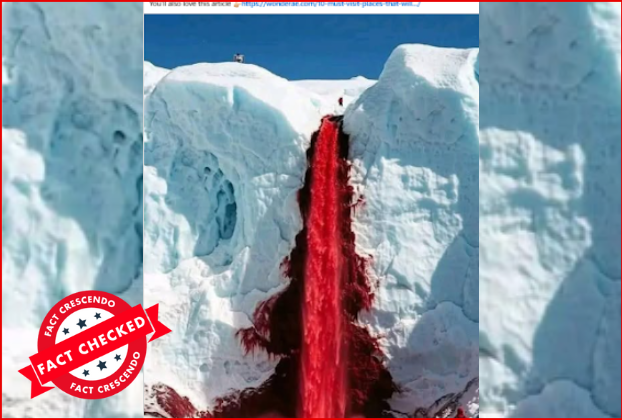Social media are filled with the discussions related to amazing creations of nature. However, sometimes digitally manipulated /created images being shared as images of natural venues. In this article, we are focusing on Blood Falls Antarctica and related misleading images.
Social media posts
With an image of flowing blood like fluid through a glacier, a social media post say, it depicts the famous Blood Falls in Antarctica.


We decided to search on this.
Explanation
First, we checked the real footages and images of glacier and found out that the real images are different than viral image being spread in social media.
The real image of Blood Falls, which is brownish red and relatively pale color than the color of viral image can be watched below.
Then, we checked the viral image using sightengine ai detector and as per it, the image most likely an AI generated one .

Then, let`s search about the details of real Blood Falls in Antarctica.
Blood Falls is a startling natural phenomenon: a stream of bright red water emerging from Taylor Glacier into Lake Bonney in the McMurdo Dry Valleys. The vivid color— reminiscent of dripping blood—has captivated explorers and scientists for over a century. In reality, the liquid is simply salty glacier meltwater rich in iron, not blood or paint. The waterfall flows at frigid sub-zero temperatures (around –7 °C) and pours out of small fissures at the glacier’s toe, creating a rust-colored cascade on the otherwise white ice. Visitors and researchers describe it as one of the most unusual sights in Antarctica: “the water emerges clear but then quickly turns crimson,” as it oxidizes in the air. More details can be read from here, here and here
Location: Taylor Glacier’s Bloody Secret
Blood Falls is located in Taylor Valley, one of the McMurdo Dry Valleys in East Antarctica. The McMurdo Dry Valleys are a high-altitude “polar desert” region largely free of ice and snow due to fierce katabatic winds and low precipitation. Taylor Glacier flows down into this valley, terminating at the north end of West Lake Bonney. GPS coordinates place Blood Falls at about 77°43′S 162°16′E.More details can be read here
Taylor Valley is surrounded by mountain ridges and contains a series of closed, ice-covered lakes with different chemical makeups. Blood Falls is unique to the western end of Lake Bonney, where an iron-rich brine seeps from the glacier. Because the falls occur well inside the continent and at about 75 meters elevation, they are far from any base or wildlife – indeed, the Dry Valleys are one of Earth’s most remote, driest places .More details can be read here
Discovery and Early Mystery
The red waterfall was first reported in 1911 by Australian geologist Thomas Griffith Taylor during Robert Falcon Scott’s Terra Nova expedition. As Taylor explored the glacier tongue, he noticed a red-stained flow along the ice. He wrote of a bleeding appearance in the ice, which led to the nickname “Blood Falls.” In those early days, explorers speculated that the color came from microscopic red algae or other biological pigments, but this was only a guess .More details can be read here
For decades, the true cause remained a puzzle. In the 1960s, glaciologist Robert B. Black analyzed samples and discovered that the stain was due to iron compounds: specifically ferric hydroxide (rust), not algae.
Why is the Water Red?
The striking red color of Blood Falls comes from iron-rich saltwater that oxidizes on the surface. Several factors combine to create the effect:
Ancient saline brine: Beneath Taylor Glacier lies an enormous reservoir of hypersaline water.This brine is essentially seawater from millions of years ago, trapped and frozen under hundreds of meters of ice . Its high salt content (~8% NaCl) prevents it from freezing solid even at –7 °C. In fact, as the brine slowly creeps into cracks in the glacier, the latent heat released by freezing saline water helps melt the surrounding ice, allowing a persistent flow year-round. In satellite radar and field studies, scientists have mapped this subglacial lake and channel network, confirming that brine flows from deep below up through the ice. More details can be read here
Iron-rich chemistry: The trapped brine dissolved vast amounts of minerals from ancient seawater and bedrock. In particular, it is loaded with ferrous iron ions (Fe²⁺). When this iron-laden liquid finally reaches the glacier’s surface, it is exposed to oxygen. The iron undergoes oxidation (“rusting”), converting to ferric iron (Fe³⁺) oxides and hydroxides. These newly formed iron oxides are reddish brown. Thus, the once-clear brine instantly acquires a bloodlike hue when it hits the air. Over time, enough ferric iron builds up that the outflow looks like streaming rust (or blood) on the glacier ice. Earlier reports identified the stain as ferric hydroxide—essentially rust—being squeezed out of the glacier.
Microbial activity: Remarkably, microbes thrive in the brine, even in total darkness without oxygen.Researchers have found a diverse community of bacteria in the Blood Falls water .These microbes are chemolithoautotrophs: they gain energy by oxidizing chemical compounds (such as iron or sulfur) in the brine rather than by photosynthesis. In doing so, their metabolism can generate additional iron oxides. For example, Jill Mikucki’s team showed that the microbes use sulfate or ferric ions in respiration, producing ferrous iron and then letting it oxidize. In short, microbial life both survives on and helps drive the iron chemistry. Many of the bacteria isolated (e.g. Marinobacter and related species) are true extremophiles – they thrive in cold, salty, oxygen-free conditions. One way to picture it: these ancient microbes essentially breathe iron and sulfur in complete darkness, and their “waste” is rusty iron that colors the waterfall. More details can be read here
Iron nanospheres: The latest research has zoomed in even further. In 2023, Johns Hopkins scientists examined solid particles from Blood Falls under powerful transmission electron microscopes. They discovered that the red tint comes from tiny iron-rich nanospheres roughly 100 times smaller than a human red blood cell. These microscopic spheres contain iron along with silicon, calcium,aluminum and other elements in an amorphous (non-crystalline) form. As soon as the brine emerges, these nanospheres rapidly oxidize, giving the water an intense crimson color. This finding explains why past tests sometimes missed the culprit: the nano-scale iron particles aren’t true minerals, so they escaped detection by older methods. In effect, each drop of Blood Falls water carries a cloud of rusting nanoparticles that give the falls its gory appearance. More details can be read here
Climate Change and the Dry Valleys
How might climate change affect Blood Falls and its surroundings? The McMurdo Dry Valleys are one of Earth’s most climate-sensitive regions. Although Taylor Glacier and the deep brine reservoir beneath it are insulated by hundreds of meters of ice, recent studies show that the valley’s environment is already changing with the warming climate.
Polar researchers have observed unprecedented warm spells in Antarctica. For example, in March 2022 an extreme heat wave (partly fueled by an atmospheric river) pushed summer-like temperatures into the Dry Valleys. Satellite and field data recorded valley temperatures more than 70 °F above average, which briefly melted surface snow and glaciers. Soils that are normally frozen even in midsummer became suddenly wet, months after the usual melt season. This “false spring” had real effects: experiments showed a 50% crash in populations of a cold-adapted nematode (Scottnema) after the heat wave, suggesting that even microscopic life cycles were disrupted by the anomaly .More details can be read here
Scientists stress that such events – once extremely rare – may become more frequent as the Antarctic climate warms. The NSF’s long-term monitoring in Taylor Valley found that with rising air temperatures, unusual autumn or winter thaws can reoccur, interrupting the normal seasonal cycle. In the decades ahead, more heat waves or wetter spells could alter glacier melt patterns and the hydrology of the Dry Valleys. For Blood Falls specifically, a warming climate might change the rate at which the icy brine is released or how fast Taylor Glacier retreats. For instance, if glaciers thin or recede, the trapped salt deposits could be exposed differently. On the other hand, increased meltwater in summer might dilute or flush out some of the brine. Researchers are actively studying these possibilities: climate models and valley observations are being used to predict how the fragile Dry Valleys ecosystems will respond to ongoing warming. More details can be read here
In summary, climate change poses a threat to the environment of Blood Falls even if the hidden lake itself remains sealed. Unseasonably warm events have already shown that the Antarctic cold desert can “whiplash” between extremes, and those changes ripple through the geology and biology. Understanding these impacts is a focus of current Antarctic research, with the hope of forecasting how one of the planet’s most pristine landscapes will evolve .
Conclusion
The viral image claiming to show Blood Falls in Antarctica is misleading. The real Blood Falls has a pale, rust-red color caused by iron-rich brine, while the viral picture is most likely AI-generated and does not represent the actual site.

Title:Blood Falls in Antarctica: Misleading Image Goes Viral Representing Nature’s Crimson Cascade
Fact Check By: Fact crescendo teamResult: Misleading






